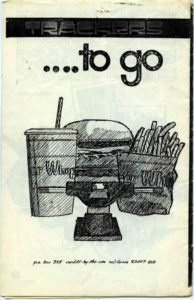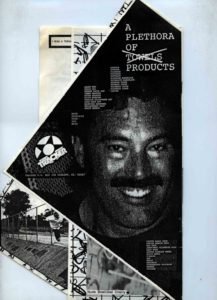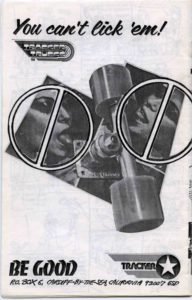Tracker Zine Ads Advertising Alternative
Tracker Ad circa 1983 Skate Fate
Tracker Zine AdsAdvertising Alternative
By GSD
The word Zine is short for magazine. A zine is a small, humble homemade publication usually printed on a photocopy machine. At the beginning of the 1980s, during skateboarding’s second depression, the full-color Skateboarder Magazine died off, soon to be replaced by the black and white newsprint called Thrasher. In their June issue, Thrasher ran an editorial that encouraged skateboarders to document their own scenes via the “do it yourself” approach. Soon, Xerox machines were humming from coast to coast, resulting in an explosion of homemade photocopied skate zines.
Claus Grabke circa 1985, the only color skate zine made, Skate Fate
Neil Blender circa 1983 Skate Fate
Tracker ads frequently appeared in these publications and although most of them were unofficial and unapproved, we really liked the homegrown feel, which served as a nice contrast to our professionally designed ads. By the mid ’80s- fueled by the backyard ramp revolution and the maturation of street skating with the Ollie-skateboarding lifted off into its hugest phase of popularity thus far. TransWorld SKATEboarding Magazine, which launched in 1983 as a full-color glossy, inspired Thrasher and later Poweredge to step up their games.
Jeff Kendall circa 1983 Skate Fate
Despite the general commercial upsurge, the homemade skate zine scene continued to expand exponentially with dozens of titles. There was a base underbelly of skateboarding that needed exposure, and homemade zines filled in this gap nicely with no nods at all to advertisers, parents, or authority. As the ’80s wound down, skate zines appeared less frequently until, by 1990, the scene became but a small murmur of its former glorious self. The time had come for the old vert and street pros of the 80’s to step aside for a new breed of young street technicians. As the world of flip tricks, handrails, and gaps inspired little in the way of homegrown photocopied napkins, the focus turned to high-quality magazines full of sharp sequences and, especially, videos to document the ever-increasing complexity of modern street skating. By the mid-1990s, a vast majority of the nutty zines of the previous decade had all but disappeared.
Tracker Ad circa 1983 Skate Fate
Dan Wilkes circa 1986 Skate Fate
Larry Balma circa 1988 Skate Fate
GSD’s Skate Fate was the premiere skate zine from 1981 to 1991, Skate Fate was the first and longest-running homemade, photocopied skate zine. It’s jam-packed with hilarious interviews, corrosive articles, breath-snatching photography, vibrant artwork, twisted cartoons, clever ads (both real and fake), and the latest news, quotes, and slang, it was all spontaneously laid out with ultra-vivid graphic design then urgently slammed into the mailboxes of fellow enthused skaters and zine makers all over the United States.
Marty Jimenez circa 1984 Skate Fate
Tracker Ad circa 1983 Skate Fate
GSD unveils The Best of Skate Fate, a mega-thick, 320-page, stark black-and-white book bursting with the most crucial content culled from the pages of nearly all 76 issues of this legendary zine. It's delivered to you fresh from the pre-computer era, when pens, pencils, paper, glue, tape, triangles, and T-squares were the tools of the trade. Scanned directly from the original master layouts, it all looks better than ever!
Exclusive full-length interviews delve into the minds of skateboarding icons Neil Blender, Steve Caballero, Steve Claar, Bill Danforth, Claus Grabke, Jeff Grosso, Tony Hawk, Christian Hosoi, Marty Jimenez, Mike McGill, Lance Mountain, Corey O'Brien and Gavin O'Brien, Chris Miller, Stacy Peralta, Rob Roskopp, Billy Ruff, Skate Rat, John Smythe (Craig Stecyk), Kevin Staab and Tod Swank.
Garry "GSD" Davis circa 1983 Skate Fate
Steve Caballero circa 1983 Skate Fate
Tony Hawk circa 1986 Skate Fate
Articles like "Xerox Scuzz" and "A Sketchy History of Skate Fate" explore the 1980s skate zine phenomenon in detail, while Neil Blender's cartoons featuring Mark Coonson and friends will leave you paralyzed by laugh attacks. Galleries of Skate Fate covers, logos, hand-drawn ads, a Skate Fate collector's guide and so much more wrap it all up. Now is the perfect time to crack open The Best of Skate Fate—a vital, surreal window into the most creative era skateboarding has ever known.
If you would like to get a copy of The Best of Skate go to: http://www.blurb.com/bookstore/detail/2374362
Tracker Ad circa 1982 Skate Fate
Tracker Mag Ad circa 1983 Skate Fate
Ray Underhill circa 1984 Skate Fate
Tracker ad circa 1983 Skate Fate
Tracker Ad circa 1984 Skate Fate
















